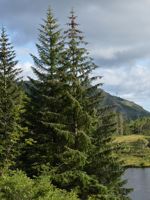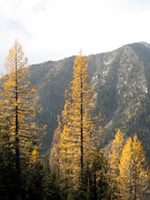Mon-Fri 9am - 5pm Mountain time
Western Larch vs Sitka Spruce
Picea sitchensis
Larix occidentalis
CUSTOM GROW
Sitka Spruce is a native conifer and the largest spruce species in the world. It grows quickly and reaches impressive heights, often reaching more than 50 metres (164 feet) in suitable conditions. It has strong, durable wood that has long been recognised for its commercial value.
It contributes to soil stability and plays an important role in coastal ecosystems. It offers cover and nesting sites for birds and small animals, and its seeds provide food for wildlife such as songbirds and small mammals.
Sitka Spruce plays a role in reforestation and ecological restoration projects in Coastal BC. It also holds historical significance: the Wright Brothers famously used Sitka Spruce to construct the frames of their first flying machines.
Western Larch is a pioneer species that can survive in nutrient poor soil and is found in the valleys and on the lower slopes of mountains in mixed forests. In the warm months, this larch is covered in clusters of soft green needles that turn golden yellow before dropping in the fall. Its dense, sturdy wood is excellent for lumber, making this Larch valuable in Western North America.

